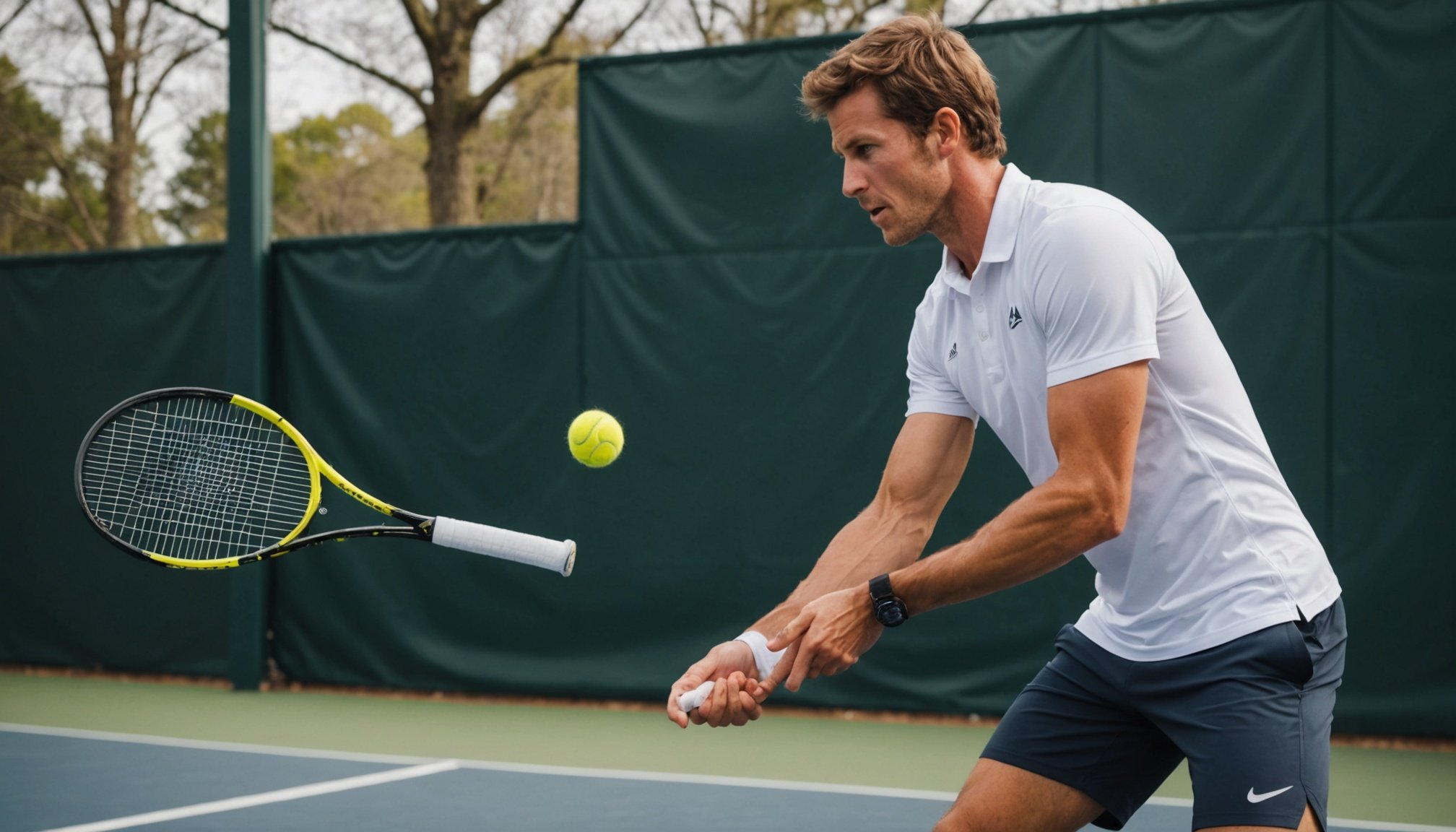Importance of Off-Season Training for Tennis Players
For tennis players, off-season training plays a pivotal role in enhancing their overall performance for the subsequent season. But what makes these training periods so essential?
An effective off-season training regimen offers numerous benefits. It allows players to focus on areas that need improvement, such as strength, endurance, and technical skills, without the immediate pressure of competition. By honing these aspects during the off-season, players return to the court more prepared and adaptable to the demands of the sport.
Have you seen this : Ultimate Guide for Lacrosse Players: Tailoring Training to Dodge ACL Injuries
Tennis performance significantly improves with consistent off-season training. Players who dedicate time to developing their abilities notice better on-court agility, quicker reflexes, and increased stamina. These improvements translate to enhanced gameplay during matches, providing a competitive edge.
Moreover, the relationship between off-season training and injury prevention is profound. Regular, structured training sessions help in strengthening muscles and joints, reducing the risk of injuries when the season commences. Players remain agile and fit, maintaining their competitive spirit while minimizing downtime due to injuries.
Also to see : Top Strategies for Enhancing Ankle Stability in Volleyball Athletes
Ultimately, off-season training is a cornerstone of player development. It cultivates a resilient mindset, preparing athletes both physically and mentally, allowing them to remain competitive and excel in their sport.
Strength Training Adjustments
Making adjustments in strength training can lead to significant muscle gains and aid in injury prevention. A few strategic changes to your routine can greatly enhance your progress.
Incorporating Functional Exercises
Integrate functional exercises into your regimen to improve overall body coordination and strength. These exercises mirror everyday activities, contributing to a more robust physique. Think squats and lunges, which not only boost muscle but also enhance stability and balance.
Targeting Key Muscle Groups
Targeting specific muscle groups is essential for achieving balanced muscle gains. Focus on larger muscle groups, like the chest, back, and legs, while ensuring smaller muscles aren’t neglected. This holistic approach fosters optimal strength and functionality.
Balancing Upper and Lower Body Workouts
Balance is crucial when designing your workouts. Ensure you incorporate both upper and lower body strength training to prevent imbalances that could lead to injuries. Compound movements such as deadlifts and bench presses are vital for strength and stability.
Incorporate exercises that enhance power and explosiveness, like jump squats. A diverse workout plan ensures all muscle groups develop evenly, contributing to effective injury prevention. Adopting a well-rounded approach not only strengthens musculature but also safeguards against potential strains.
Conditioning for Endurance
Building conditioning is pivotal to enhancing tennis performance. It’s not just about physical power but also about enduring lengthy matches. Developing tennis fitness and stamina through appropriate conditioning routines is key to outlasting opponents.
Aerobic vs Anaerobic Training
To optimise stamina, it’s important to differentiate between aerobic and anaerobic training. Aerobic exercises like long-distance running help enhance overall endurance by improving the body’s oxygen utilisation over time. In contrast, anaerobic training, such as sprinting, focuses on high-intensity bursts of energy, which is critical for short, intense rallies.
High-Intensity Interval Training (HIIT)
High-Intensity Interval Training (HIIT) is highly effective for boosting stamina. Its alternating phases of intense activity and short rest periods mirror the stop-start nature of a tennis match. HIIT improves conditioning rapidly, enabling players to sustain energy throughout a match.
Sport-Specific Conditioning Drills
Tailoring workouts to simulate match conditions considerably benefits a player’s tennis fitness. Drills focused on replicating the intensity of matches can lead to improved performance. Incorporating agility drills enhances court movement, allowing players to respond swiftly. The benefits of varied training intensities cannot be overstated, as they contribute to all-rounded conditioning essential for competitive tennis.
Skill Development Focus
In the realm of tennis, developing technical proficiency through structured training is vital. Effective skill development strategies often hinge on targeted drills designed to elevate aspects of a player’s game. Whether honing a precise serve or refining footwork, these tennis drills form the backbone of practice sessions.
Emphasis on Weaknesses
An integral part of skill development involves identifying and focusing on personal weaknesses. Players should analyse their gameplay to determine areas requiring improvement. Concentrating efforts on these weaker aspects often results in a more well-rounded and competitive athlete.
Variety of Drills to Improve Skills
Regularly incorporating a variety of drills can significantly boost a player’s skill set. For instance, practicing cross-court shots can improve accuracy and control, while endurance drills enhance stamina during long matches. Integrating diverse exercises ensures holistic development and keeps training engaging.
Incorporating Video Analysis
Utilizing video analysis is a transformative method in modern training, enabling players to evaluate performance comprehensively. Recording practice sessions allows athletes to visually identify errors or inconsistencies, facilitating targeted corrections. This technological approach promotes a deeper understanding of technical proficiency and tracks the progression of skill development over time.
Mental Preparation Techniques
Cultivating mental toughness is essential for athletes striving to achieve peak performance. A strong competitive mindset can often be the difference between success and failure. Drawing from sports psychology, several strategies can enhance focus and concentration, helping athletes remain calm and poised.
One popular technique is visualization—a mental exercise where athletes imagine themselves succeeding in specific scenarios. This practice helps prepare the mind for real-life competition, fostering a sense of familiarity and confidence in the face of challenges. Consistently engaging in mental rehearsal can reinforce desired performance outcomes, enabling athletes to navigate high-pressure situations with ease.
Overcoming performance anxiety is another critical aspect of preparation. Techniques such as deep breathing, progressive muscle relaxation, and mindfulness can reduce stress levels, allowing athletes to maintain focus during competition. Incorporating these practices regularly can build resilience, enabling athletes to approach competitions with more confidence and less anxiety.
Athletes benefit greatly from setting specific, achievable goals. Goal-setting not only provides a clear direction but also reinforces motivation and commitment. By setting both short-term and long-term objectives, athletes can track their progress and stay motivated, ultimately enhancing their mental toughness and competitive mindset.
Recovery and Injury Prevention Strategies
Understanding recovery techniques and injury prevention is crucial in athletic training. Implementing structured rest periods can significantly enhance performance and reduce the likelihood of injuries.
Importance of Active Recovery
Active recovery involves engaging in low-intensity exercises following a high-intensity workout. This aids in maintaining blood flow to muscles, promoting efficient removal of metabolic waste. Effective active recovery can lead to faster muscle repair and a decrease in muscle soreness, ensuring athletes are ready for their next training session.
Incorporating Flexibility and Mobility Work
Integrating flexibility and mobility exercises is vital for maintaining joint health and preventing injuries. Regular stretching and foam rolling can improve flexibility, enhance the range of motion, and contribute to better overall movement patterns. Being consistent with these practices can also reduce muscle stiffness and mitigate the risk of strain or sprain injuries.
Nutrition’s Role in Recovery
Nutrition significantly impacts how effectively our bodies recover. Consuming a balanced diet rich in protein, carbohydrates, and essential fats supports muscle repair and energy replenishment. Adequate hydration is also key, as it facilitates nutrient transportation and regulates body temperature. Tailoring nutritional intake to one’s individual needs can greatly enhance recovery efficiency.
Examples of Effective Off-Season Training Regimens
Embarking on an off-season program can be a game-changer for athletes aiming to enhance their performance. To illustrate the potential of these programs, let’s delve into some inspiring success stories.
Case Studies of Successful Players
Some prominent athletes attribute their achievements to meticulously planned training schedules during the off-season. By examining their regimens, we can uncover patterns that contribute to excellence. For instance, elite footballers often integrate varied activities like cardio, strength training, and skills refinement. Basketball stars, on the other hand, frequently adopt agility-focused workouts to enhance their court performance. These case studies reveal the diversity and customisation necessary for peak conditioning.
Sample Weekly Training Schedule
Creating an effective off-season program requires a well-structured training schedule. A typical week includes:
- Monday: Cardio endurance and muscle toning
- Wednesday: Skill drills and agility training
- Friday: Strength-building exercises
- Weekend: Active recovery and flexibility sessions
Tailoring the above can foster sustained development towards individual fitness goals.
Expert Recommendations and Insights
Experts, including experienced coaches and trainers, stress the importance of crafting personalised off-season training routines. The right strategy should balance physical demands with recovery, accommodating individual capabilities. By following structured regimens and staying consistent, athletes can maximise their potential.
Understanding Off-Season Training Importance
Navigating the off-season requires strategic planning to maximize benefits. It’s a period essential for laying the groundwork that substantially enhances tennis performance. While regular season training focuses on peak performance and competition readiness, off-season training shifts emphasis. The goals diversify—focusing on recovery, addressing weaknesses, and building on skills without the pressures of competition.
Key benefits include allowing athletes to fully recover from minor injuries and physical fatigue, thus preventing wear and tear. Skill development can be prioritized without the immediacy of matches, enabling players to refine techniques or experiment with new strategies. Additionally, concentration on strength and conditioning helps in bolstering endurance and power that can be pivotal during competitive match play.
Comparatively, while in-season training is rigorous and focused on maintaining top form, off-season serves as a period for self-improvement. It’s an opportunity to realign training to personal needs and long-term goals rather than just immediate competitive demands. By understanding the unique opportunities within the off-season, players can emerge stronger, refreshed, and equipped with enhanced capabilities for future tournaments. Embracing this form of training ensures continuous improvement and resilience in a player’s career.
Structuring an Effective Off-Season Training Plan
An effective training plan can significantly boost your skill development during the off-season. It’s crucial to ensure your plan is not just a series of arbitrary exercises but a carefully designed program aimed at specific improvements.
Setting Realistic Goals
When creating a training plan, the first step is to set realistic goals. Goals should be measurable objectives that are tailored to your personal development needs. These could include improving endurance, enhancing agility, or increasing strength. By having clear goals, you can focus your energy effectively and track your progress over time.
Assessing Current Skill Levels
Before you begin, it’s essential to assess your current skill levels. This step is crucial for identifying areas where you excel and areas that need improvement. By incorporating skill assessments into your plan, you will have a more comprehensive understanding of your abilities, enabling you to design targeted training sessions.
Establishing a Schedule
Establishing a flexible schedule is key to an off-season training plan. It’s important to find a balance between training frequency and rest. Too much training can lead to burnout or injuries, while insufficient training might fail to maximize potential gains. Allocate sufficient rest periods to allow for recovery, which is when the body actually strengthens and adapts to the training.
Physical Conditioning Techniques
Achieving optimal physical conditioning requires a balanced approach focusing on strength, agility, and endurance. To enhance strength and agility, incorporate exercises such as weightlifting, plyometrics, and bodyweight activities. These exercises challenge different muscle groups and improve overall muscle coordination.
Endurance training includes cardiovascular activities like running, swimming, or cycling. These activities increase heart rate and improve the body’s ability to sustain prolonged activity, making them essential for developing stamina. It’s crucial to vary intensity and duration to effectively build endurance.
Flexibility and mobility play a crucial role in maintaining an athlete’s overall physical conditioning. Incorporating routines such as yoga or dynamic stretching ensures muscles remain pliable, reducing the risk of injury and improving movement efficiency. Regular flexibility exercises contribute to better performance by enhancing movement range and fluidity.
In summary, a successful physical conditioning strategy combines strength and agility exercises, cardiovascular training, and dedicated flexibility routines. This holistic approach equips individuals with enhanced capability and resilience in physical activities. Always listen to your body and adjust your regimen to ensure well-rounded development.
Sport-Specific Skill Enhancement
Improving specific skills in sports requires targeted drills and consistent practice. These are essential for any athlete aiming for superior performance.
Drills for Stroke Improvement
To achieve technique improvement, one must engage in drills concentrating on various strokes. For instance, tennis players should focus on repetitive practice for backhand and forehand strokes, refining their technique with each swing. This methodical approach ensures muscle memory development, ultimately leading to more precise and powerful shots. Drills also aid in recognising weaknesses and transforms them into strengths over time.
Footwork and Court Movement
Skill enhancement isn’t complete without mastering footwork and court movement. Precision in footwork is pivotal in many sports, such as basketball, where lateral movement allows players to defend effectively. Practising agile direction changes enables quick responses, which are crucial during competitive play. Proper footwork helps athletes maintain balance and stamina throughout matches, contributing to overall performance improvement.
Practicing Match Simulations
Practicing match simulations provides athletes the benefit of real-life scenarios. These simulations allow for technique improvement under pressure, exposing athletes to situations they might encounter in actual matches. It is an excellent way to apply skills learned during drills in a competitive environment, fostering skill enhancement and strategic thinking. Participants learn to adapt and execute strategies effectively, honing their instincts.
Nutrition Strategies for Optimal Performance
Achieving optimal performance in tennis is not just about technique and skill—it also hinges on smart nutrition. Tailoring your dietary intake can significantly complement your training demands. For instance, increasing carbohydrates fuels high-intensity workouts, while proteins aid in recovery and muscle repair. Balancing these macronutrients is crucial.
Hydration stands as one of the most critical components. Regular and adequate fluid intake is essential to maintain performance levels and prevent dehydration. Especially during matches lasting several hours, consistent water and electrolyte replenishment can make a notable difference.
Recovery nutrition is equally important post-match or workout. Consuming a combination of proteins and carbohydrates within 30 minutes after play can assist in muscle recovery and energy restoration. This approach supports muscle synthesis and replenishes glycogen stores.
Let’s consider sample meal plans. A breakfast rich in complex carbs, such as oatmeal with fruits and nuts, fuels morning sessions. Lunch could consist of lean proteins like grilled chicken or chickpeas with whole grains. Dinner might include salmon with sweet potatoes and a side of leafy greens, focusing on both recovery and overall health. These dietary adjustments not only enhance performance but also promote overall well-being.
Injury Prevention and Management
Understanding injury prevention is essential for athletes, especially those in tennis, where repetitive movements can lead to common injuries. Managing these requires attention to both exercise and rehabilitation.
Key Strengthening Exercises
Strengthening exercises specifically targeted at areas prone to injury, such as the shoulder, wrist, and lower body, can significantly reduce the risk of injury. Incorporating resistance bands or weights into routines helps build resilience in muscles and joints, supporting better performance and lessening strain during play.
Warm-Up and Cool-Down Routines
Engaging in comprehensive warm-up and cool-down routines is critical. A proper warm-up increases blood flow to muscles, enhancing flexibility and reducing the risk of acute injuries. Cool-down routines aid in gradual recovery, helping to reduce lactic acid build-up and prevent muscle stiffness.
Recognizing Early Signs of Injury
Early recognition of injury is vital. Learning the signs of strain, such as persistent soreness or swelling, enables timely intervention and effective rehabilitation. Self-assessment strategies, like monitoring pain levels and the impact of certain movements, can guide decisions about seeking professional assistance or adjusting activity levels to prevent further damage.
Mental Conditioning Strategies
Mental conditioning is a crucial element in achieving peak performance across various disciplines. By dedicating time to enhancing mental strength, individuals can overcome challenges with greater ease. One effective approach is by developing a mental training regimen. This involves regular practice and consistency, much like physical exercise. Setting specific goals and tracking progress can help maintain focus and motivation.
Another powerful tool is visualization. Visualization techniques for performance enhancement allow individuals to mentally rehearse situations, tapping into the mind’s creative power to envision successful outcomes. This prepares the brain to respond positively during actual performance, thus boosting confidence.
Off-season periods, although essential for rest, can lead to waning motivation. Implementing strategies to sustain enthusiasm and drive during these times is crucial for long-term success. Techniques such as setting new objectives or diversifying one’s skillset can keep the mind engaged and prevent burnout. Regular self-assessment and reflection further help in maintaining an optimal focus.
By integrating these strategies into one’s routine, individuals can foster resilience and concentration. Investing time in mental conditioning not only aids in addressing immediate hurdles but also builds a strong foundation for continued growth.
Expert Insights and Case Studies
Explore the expertise and insights provided by top professionals on training enhancements. This section ventures into the realistic world of success, diving into experiences directly from the field.
Interviews with Tennis Coaches
Delve into the expert insights shared by seasoned tennis coaches. These experts reveal their strategies for honing the talents of budding players. For instance, many advocate for a balanced training regimen that combines technical drills with psychological resilience exercises. One coach highlights the importance of adaptability, noting how changes in player fitness levels can impact the need for program adjustments.
Success Stories from Professional Players
Discover real-life examples from successful players. These athletes often cite adaptive strategies as key to their achievements. One popular example is a player’s transition from a traditional training plan to a more specialized routine focusing on reactive speed and agility, which substantially improved their game performance. Such stories offer invaluable lessons on perseverance and strategic thinking.
Analyzing Training Regimens of Elite Athletes
Analyzing the training regimens of elite athletes offers a window into their disciplined routines. These real-life applications emphasize the importance of consistency. Elite athletes frequently revisit their strategies, studying previous matches to identify areas for growth. This gaining insight into constant refinement is vital for any player intending to reach the top tier of their sport.
Creating a Structured Off-Season Training Schedule
Designing a structured training schedule is essential for maximising off-season progress. Begin by developing a 4-6 week plan that comprehensively outlines all workout and recovery activities. A weekly plan should incorporate various elements such as strength training, cardiovascular exercises, flexibility sessions, and rest days to ensure balanced development.
Incorporate varying intensities and modalities to target different fitness aspects. For instance, mix high-intensity interval training (HIIT) with steady-state cardio to enhance endurance and stamina. Strength sessions should focus on both compound lifts and isolation exercises to build and maintain muscle groups.
To maintain motivation and progress, regularly track your achievements and assess whether adjustments are needed. Monitor key metrics, such as reps, sets, or time spent on activities. Monthly reflections will help identify areas that may require more focus or a change in routine.
Consider introducing new exercises or adjusting current ones to break plateaus and keep engagement levels high. By reviewing your goals and adjusting the training schedule accordingly, you ensure adaptability and continued improvement throughout the off-season. Remember, this dynamic approach to your weekly plan will yield the best results.











